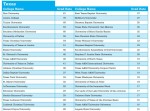According to federal statistics on college graduation rates, only 27% of college students who attend public colleges graduate in four years. Private schools have a slightly better track record: 48% of students get their college degree in four years. Private for-profit colleges have even worse graduation rates (don’t get me started on those so-called “schools”). Either way, those are some disappointing figures!
Colleges also use their 6 year college graduation rates to help turn focus away from the small 4-year graduation rate numbers. Unfortunately, we still aren’t graduating more than half of all students who enter higher education: Texas ranks 35th in the nation with our 6-year grad rate of 48%. (source: Higher ed)
Some say it’s not a big deal if students stay in college longer. As long as they get their college degree, what’s the difference? Well, if you’re paying  for your child’s college like most parents, the difference is another year or two of tuition, and room and board, and books and other miscellaneous expenses. It adds up: with the average public college cost of attendance, parents are looking at more than $22,000 a year, or about $89,000 for four years. Stretch that into 6 years and suddenly you’re spending more than $133,000.
for your child’s college like most parents, the difference is another year or two of tuition, and room and board, and books and other miscellaneous expenses. It adds up: with the average public college cost of attendance, parents are looking at more than $22,000 a year, or about $89,000 for four years. Stretch that into 6 years and suddenly you’re spending more than $133,000.
If your student is considering private colleges, the annual $43,000 price tag totals $173,000 for 4 years. Sticking around for two more years increases that already-high number to a shocking $260,000! (Source: College Data)
- Graduation rates of colleges in Texas
- Graduation rates at Oklahoma colleges
- Graduation rates at Arkansas and Arizona
- Louisiana graduation rates
- Graduation Rates based on college selectivity
So, what are some things that parents can do to help their children graduate from college on time, or at all? What can we all do to increase college graduation rates and help the future generation? Here are some helpful tips that I’ve learned from years of assisting parents and families through the college admissions process:
1. Encourage your college kid to explore different college majors and careers before they declare it as a major.
Some students know exactly what they want to do right from a very early age, but these are the exception. Most kids aren’t completely sure which major is right for them, understandably so since they are still trying to “figure out themselves”. During high school, students should research and consider many different career fields. They can, and should, take different course electives which should introduce them to various career options. They can talk to professionals in the field, and they can search for internships or job shadowing opportunities in those fields. MyEdu is a great tool.
If you are still unsure, they can use the first year of college to focus on general education courses while trying to decide. Most college major paths and curriculum begin to narrow down to specific coursework quickly so some students lose credits and transfer classes if they don’t declare their major before the end of freshman year.
2. Talk to the college advisor, but remember to double check everything.
Every major has a specific track of courses and electives. College advisers are there to help make sure students get on the right path and not veer into the land of wasted credits. Your kid should always check in with their adviser if they have any doubts about a class they want to take. The key is to be proactive and ASK QUESTIONS. It’s also smart for your college kid to talk to more than one adviser, chat with their classmates and double check the info they get.
Because degree plans, AP credits, summer classes and CLEP credit can all add to the confusion of transfers and college graduation rates, Brand College Consulting also helps current college students with academic support and guidance. Learn more here.
3. Look into community college credits on school breaks.
Most college students spend the school holiday break over Christmas and the summer relaxing. They certainly need to relax and de-stress, but this is also a great opportunity to take a course or two at a local community college.
My oldest was home for more than a month during December and January from his first year at Texas A&M. We signed him up for a winter mini-course at the local community college and he was able to earn 3 college credits quickly and easily. It was also much cheaper than paying for the equivalent course at A&M.
One word of caution: I would not recommend courses in the student’s major taken at community college. The Aggie son is an Engineering major, so taking a Communications course or an Art History course at a community college is fine, but I wouldn’t want him to take an important Math or Science class there.
4. Talk about their class load.
Students who move away to college traditionally have transition issues and freshman year is a rough adjustment. I usually suggest students take 12-15 hours each semester of their first year. They can go up to 18 or 21 hours after they have gotten comfortable with the work load.
Mixing “hard” classes with a few “easy” ones is also a good idea initially. Several classes that require lots of reading and essays, such as an English, History, Political Science, and Psychology class will be tough on a STEM major. The opposite is also true: students who aren’t strong in Math and Science should only take one at a time, initially.
These tips should help students who might otherwise want to drop classes after the semester begins and increase college graduation rates.
Think these tips will help you get your kid to graduate in four years? Let us know! And if you have any questions, please feel free to use our Contact Form.
Related Articles





